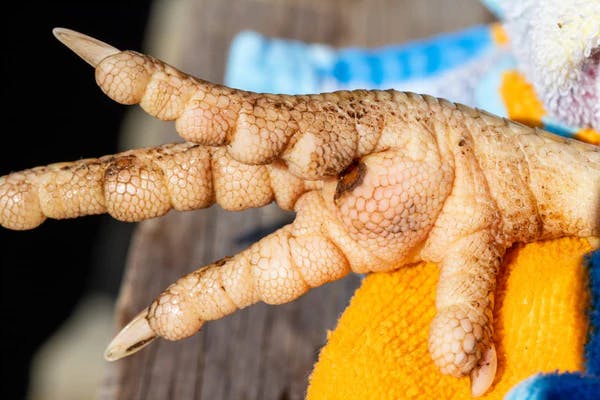
Have you noticed any of your chickens limping or showing swelling in one of their legs? If so, you must check them for bumblefoot. This common yet potentially dangerous bacterial infection can cause significant discomfort and even lead to severe complications if left untreated. However, with the right knowledge and tools, you can effectively prevent and treat bumblefoot in your chickens.
Understanding Bumblefoot
Bumblefoot, scientifically known as pododermatitis, emerges as a bacterial infection affecting chickens' feet. It typically stems from an injury that becomes contaminated with bacteria such as Staphylococcus aureus, E-coli, and Pseudomonas. This infection often presents as a painful welt or abscess on the skin, leading to swelling, soreness, and limping in the affected chicken. If left untreated, bumblefoot can escalate, spreading to other foot tissues and tendons, potentially causing severe complications and becoming life-threatening.
Causes and Risk Factors
The development of bumblefoot in chickens is primarily linked to foot injuries that become infected with bacteria. Common triggers include sharp or rough surfaces in the coop, jumping from high roosts, or exposure to splinters from rough roosts or bedding materials. Additionally, environmental factors such as wet or soiled bedding, cold weather conditions, obesity, and inadequate nutrition can weaken a chicken’s immune system, heightening susceptibility to infections like bumblefoot.
To minimize the risk of bumblefoot in your flock, it’s crucial to maintain meticulous coop management practices. This includes keeping the chicken coop clean and dry, steering clear of sharp objects like wire flooring, and providing smooth but not slippery roosts. Furthermore, ensuring proper nutrition and weight management among your chickens can aid in preventing obesity-related bumblefoot issues, fostering overall flock health and resilience against infections.
Identifying Bumblefoot Symptoms
Detecting bumblefoot in chickens requires a keen eye for symptoms indicative of the condition. Look out for the following signs:
- Limping or Favoring One Leg: Chickens with bumblefoot often exhibit a reluctance to put weight on the affected leg.
- Decreased Activity: Infected chickens may show reduced activity levels, avoiding movement due to discomfort.
- Swelling and Soreness: The affected foot, particularly the toes or footpad, may display noticeable swelling and tenderness.
- Welt or Abscess: A prominent boil or abscess on the skin of the chicken's foot is a hallmark sign of bumblefoot.

Regularly inspect your chickens’ feet for any signs of injury or infection. Addressing issues promptly can prevent the development of bumblefoot and mitigate further complications. Immediate consultation with a local vet experienced in treating poultry is crucial if symptoms are observed, ensuring proper care and treatment for affected chickens.
Treating Bumblefoot
Treating bumblefoot in chickens involves a systematic approach to clean the wound, apply appropriate medications like triple antibiotic ointment, and dress the wound with vet wrap to protect it from further contamination. In severe cases, where the infection has spread or deepened, surgical intervention and antibiotics prescribed by a veterinarian may be necessary. Remember, early diagnosis and treatment are paramount for optimal outcomes and preventing further complications.
Preventive Measures
Preventing bumblefoot requires a holistic approach that includes foot injury prevention, diligent coop management, proper nutrition, and regular health monitoring of your flock. Implement the following preventive measures:
- Maintain Clean and Dry Coops: Ensure your coop remains clean, dry, and free from sharp objects and chicken waste.
- Provide Suitable Roosts: Install smooth and appropriate roosts to minimize foot injuries among chickens.
- Healthy Nutrition: Offer a balanced diet to your chickens, preventing obesity-related bumblefoot risks.
- Regular Health Checks: Conduct routine foot inspections and address any issues promptly to prevent bumblefoot development.
By adhering to these preventive measures and maintaining a proactive approach to flock health, you can significantly reduce the likelihood of bumblefoot affecting your chickens, fostering a healthy and resilient flock.
Conclusion
Understanding bumblefoot causes, symptoms, treatments, and preventive strategies is crucial for maintaining the well-being of your flock. Early detection, prompt treatment, and proactive preventive measures are key to managing bumblefoot effectively. If you need further assistance or have concerns about bumblefoot in your chickens, don’t hesitate to reach out to us. We’re here to support you and your flock every step of the way.
